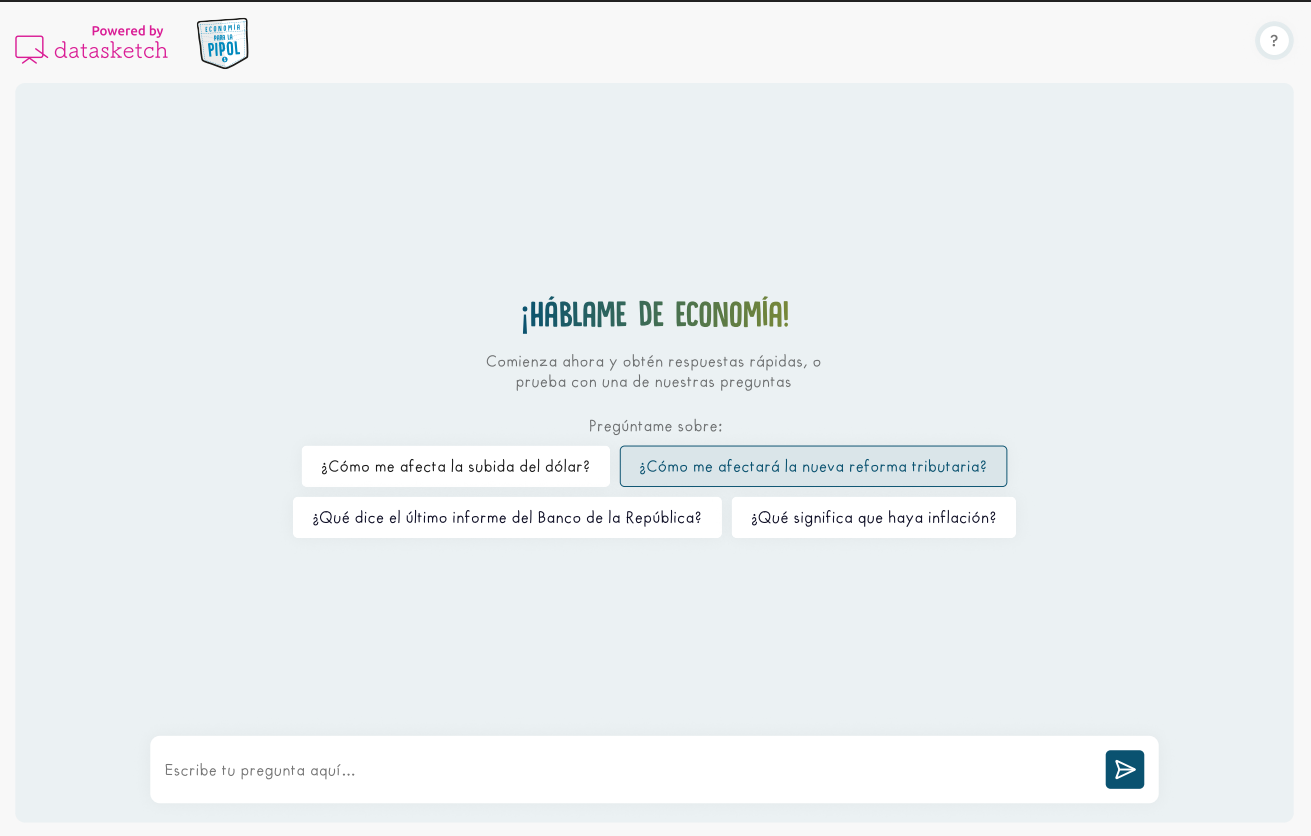A chatbot bringing economics closer to “la pipol”
Economía para la Pipol and Datasketch are on a mission to make economics more accessible in Colombia. Learn how their AI-powered chatbot is being built to bridge this gap
Landing page for Economía para la Pipol chatbot.
By: María Camila González, from Economía para la pipol and Juan Pablo Marín, from DataSketch
In Colombia, and perhaps around the world, there is a gap between decision-makers and those who experience the consequences of their actions. This gap is marked by a lack of knowledge and the use of specialised jargon which distances the two groups. At Economía para la Pipol and Datasketch, we want to change that. Our chatbot, built through the JournalismAI Innovation Challenge, supported by the Google News Initiative, is one way we’re working to do just that.
Economía para la Pipol (“Economy for the people”), a Colombian digital media outlet, teamed up with DataSketch, a platform that helps make data more accessible, to build a tool that brings economics closer to everyone.
Since January 2025, our two teams have been working together – mixing journalism, data, and AI – to build a chatbot that can answer people’s tough questions about the economy and money in a way that’s easy to understand. We dream of it becoming a tool that allows citizens to make better and more informed financial and political decisions.
To get our chatbot ready for launch in September, we mapped out a few milestones to guide us through key steps – such as conducting research, building the database the chatbot will run on, and designing and developing the underlying technology.
Landing page for Economía para la Pipol chatbot.
The challenge of accessing public information
With the interactive chatbot we’ve taken the challenging task of finding, collecting, organising, and translating economic and financial information to build a comprehensive database. To do this, we started with content published on Economía para la Pipol’s social media channels over the past eight months.
Starting from our first batch of content, we created sub-questions and short answers using our journalistic research, as well as new information requests submitted to official entities that held the answers. So far, the database contains more than 700 questions and answers.
The challenge? Keeping the database up-to-date with the latest economic information and also with other official datasets that are constantly updated. To address this we’ve been working on a system that connects automatically with certain datasets from the Dane (the National Administrative Department of Statistics), so our chatbot can automatically update itself.
Designing an intuitive tool for everyone
From the earliest stages of conceptualisation, Datasketch's approach to building this economics chatbot has been deeply rooted in human-centered design principles. Rather than focusing on generic economic questions, we mapped the specific queries that Economía para la Pipol frequently receives through its social media channels and publications.
This approach ensured the chatbot addresses the actual economic concerns of Colombians rather than theoretical concepts. The design process emerged from numerous in-depth conversations with the Economía para la Pipol team to define optimal response strategies, carefully considering both the functional capabilities a chatbot should possess and the graphic elements we identified as relevant for economic communication.
This collaborative methodology allowed us to create a tool that authentically represents their established approach to explaining complex economic concepts in accessible terms.
Landing page for Economía para la Pipol chatbot.
Technology as a tool for “la pipol”
The technical implementation combines our data visualisation expertise with an innovative approach to information retrieval. A cornerstone of our development has been connecting the chatbot with Colombia's official public databases, allowing it to extract and present specific economic data that's continuously updated. This gives users access to real-time indicators, as opposed to static explanations.
While still in development, the system already effectively recognises Colombian economic terminology and provides answers grounded in official sources rather than generic responses. This makes it a tool that delivers reliable, contextualised economic insights enhanced by clear visual representations.
What’s coming up
As part of the process – which has been very exciting for both organisations – we’ll continue working on the question database, conducting broader tests with the design prototype, and moving forward with the technological development of the chatbot.
—
This article is part of a series providing updates from 35 grantees on the JournalismAI Innovation Challenge, supported by the Google News Initiative. Click here to read other articles from our grantees.




